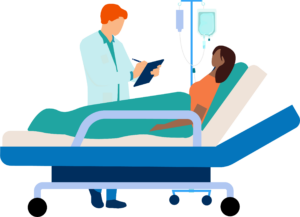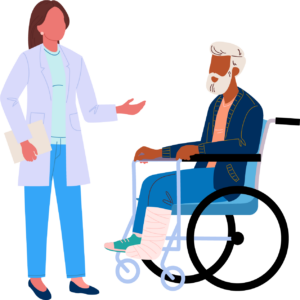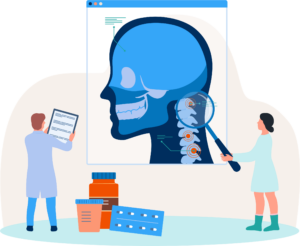Risky Substance Use and Surgery
As substance use disorders increases across the nation, helping patients progress safely and comfortably through surgical recovery after a procedure is critical. OPEN strives to educate surgical care providers and teams on the importance of screening for risky substance use, how to screen using a standardized screening tool, interpreting screening results, and acting on a high-risk score.
What is Risky Substance Use?
Risky substance use refers to the consumption of alcohol, drugs, or other substances in a way that increases the likelihood of negative consequences, even if the person has not developed a substance use disorder (SUD). This is a complex health issue that impacts millions of lives every day.
In striving to provide comprehensive, patient-centered care, it is imperative that health care systems integrate strategies across all kinds of patient interactions. Risky substance use can have a negative impact on surgical outcomes. For example, even when used as prescribed, opioid use increases risk for complications and readmissions. Other substances likely have similar effects.2
Risky Use Does Not Equal Substance Use Disorder
It is important to recognize that not all patients identified as having risky substance use have a substance use disorder and in fact, many do not. However, even patients with risky substance use are at risk for adverse health and surgical outcomes. Continued risky use may put someone more at risk to progressing to a Substance Use Disorder (SUD).
To be diagnosed with a SUD, someone must meet DSM-5 criteria, which can be categorized as mild, moderate, or severe.
Addiction is the most severe form of SUD. Addiction is a treatable, chronic medical disease involving complex interactions among brain circuits, genetics, the environment, and an individual’s life experiences. People with addiction use substances or engage in behaviors that become compulsive and often continue despite harmful consequences. Addiction to substances produces changes in brain structure and function that promote and sustain addiction and contribute to relapse. These brain changes endure long after an individual stops using substances. Addiction is not an inevitable consequence of substance use.
Whether an individual ever uses alcohol or any other substance, and whether that initial use, progresses to risky or problematic use or a SUD of any severity depends on a number of factors:
- An individual’s genetic makeup and other biological factors
- The age of first use
- Psychological factors related to an individual’s unique history and personality
- Environmental factors such as the availability of drugs, family and peer dynamics, financial resources, cultural norms, exposure to stress and access to social supports
Impact in Surgery
Risky substance use can significantly impact both the outcome of surgical procedures and the management of patients undergoing surgery. For example, substance use could lead to:
- Altered physiological responses influencing anesthesia requirements and pain sensitivity
- Enhanced risk of respiratory complications during and after surgery
- Impaired wound healing and increased susceptibility to postoperative infections

- Prolonged recovery times due to compromised overall health status
- Higher likelihood of adverse reactions or interactions with postoperative medications
- Increased risk of postoperative return to use or overdose, especially with exposure to opioid painkillers
- Necessitates tailored perioperative care plans, including non-opioid pain management strategies
- Requires vigilant monitoring for withdrawal symptoms and potential complications
- Coordination with addiction treatment services for comprehensive postoperative care
- Essential identification and assessment of substance use disorders preoperatively for risk mitigation and improved outcomes
Risky Substance Use Impacts Prescription Opioid Use Before and After Surgery
Using tobacco, alcohol, opioids, or other drugs may make patients more likely to take prescription opioids before and after surgery.
Risky Substance Use Impacts Surgical Outcomes
Using tobacco, alcohol, opioids, or other drugs may make patients more likely to have adverse outcomes after surgery.
Substance Use Screening
 Identifying patients who may have risky substance use is most successful when done in a non-biased, non-stigmatizing way. Universally screening patients using a validated, standardized screening tool such as the Tobacco, Alcohol, Prescription medications and other Substances (TAPS) screening tool helps to mitigate these factors.5
Identifying patients who may have risky substance use is most successful when done in a non-biased, non-stigmatizing way. Universally screening patients using a validated, standardized screening tool such as the Tobacco, Alcohol, Prescription medications and other Substances (TAPS) screening tool helps to mitigate these factors.5
The screening questions can be self-administered or administered by clinic staff. Patient responses to the questionnaire generate a risk score, which can help providers understand more about their patient and indicate if further assessment is needed.
Universal Screening
OPEN recommends screening everyone for risky substance use and possible substance use disorder before surgery, coordinate care, and share resources.
Comparison of Presurgical Screening for Diabetes and Substance Use
Substance use disorder (SUD) is a chronic medical condition—much like diabetes or hypertension. Just as patients are routinely screened for conditions like high blood pressure or elevated blood sugar before surgery, it’s equally important to include standardized screening for substance use as part of routine medical intake.
Real World Insights
Standardized Tool Detected More Patients at Risk
OPEN conducted a pilot project that included 242 patients, comparing their TAPS scores to documentation in the health record after preoperative evaluations for substance use risk. Most patients that were identified by the screening tool as at risk had no indication of this risk in the chart. While there were gaps for all substances, alcohol was most common and the least likely to be identified in the chart documentation.6
70% of patients screened positive by TAPS were missed by routine EMR documentation.
Screening: Acceptable and Feasible
An OPEN study looking at survey responses from 470 patients found that7:
- 98% of those participating found screening pathway acceptable
- 1.7% reported feeling uncomfortable with questions
- Non-face to face interactions preferred
Using qualitative methods, OPEN found that providers, including surgeons, PCPs, and anesthesiologists, value a standardized, multidisciplinary approach to perioperative opioid management focusing on3:
- Patient education
- Provider communication
- Tools that can identify patients at high risk
What to do With High Risk Screening Results
Part of the challenge and preparation in implementing universal screening is ensuring preparation for what happens next. While the specific details will be dependent on each hospital, available resources within the system, and additional community supports, general steps include:
1. Confirm screening results
Providers should discuss the screening results with the patient and confirm through the preoperative history and physical and a review of substance use.
2. Discuss potential perioperative risks
Express concern and how this risky substance use can impact the patient’s outcomes related to surgery.
3. Create a perioperative plan of care
Ensure there are appropriate perioperative care modifications and plans in place to mitigate risk as best as possible. For example, consulting with anesthesia when greater than normal pain is anticipated. See Plan of Care templates.
4. Share resources
Make patients aware of resources in the hospital or in the community that they can utilize in receiving support and/or treatment for substance use disorder.
Talking With Patients About Substance Use
Language plays a pivotal role in reducing stigma associated with substance use by shaping perceptions, influencing behaviors, and promoting empathy. How we talk about substance use can either contribute to or reduce stigma, making it crucial to use language that emphasizes SUD as a chronic medical disease, not a personal choice or failing. A shift in language not only impacts how individuals with SUD view themselves—reducing internalized shame and encouraging recovery—but also influences the attitudes and behaviors of healthcare providers, fostering more respectful, unbiased care.
Learn more about Stigma
Conversation Starters
Adapted from Empathy: Talking to Patients About Substance Use Disorder (CDC.gov).9
Ask Permission + Provide Options
“Would it be ok with you if I asked you some questions about your substance use?”
Normalize the Conversation
“This is not unusual. Many patients find it hard to talk about their substance use.”
“Talking about substance use can be uncomfortable.”
Be Transparent
“I need to ask you some specific questions about your use of (substance). This will help us to determine the best plan of care for you for surgery.”
Address Confidentiality + Concerns Honestly
“I want you to know that everything you share with me and that we discuss today is confidential. However, there are some limited exceptions under the state law that I want to make sure you know and understand such as reports of threats of harm to yourself or others.”
Establish Trust + Show Empathy
Actively listen and engage with patients in a non-judgmental way. Treat patients with respect and address their SUD as the medical disease that it is.
Work Together with Patients
Meet patients where they are in their journey. Not every patient will be ready to stop their substance use.
Standard Screening Implementation
Implementing screening for risky substance use is an essential step in early identification and intervention, paving the way for better health outcomes. It requires a standardized approach and trained staff to effectively assess risk and provide appropriate referrals for treatment.
Form a Project Team
- Assemble a multidisciplinary group of dedicated professionals who are committed to enhancing risky substance use identification and intervention
- This group may include clinicians, nurses, social workers, and administrative staff who understand the nuances of substance use
- Identify clear objectives for the screening process and intervention
- Conduct a needs assessment to review current practices and barriers
Investigate Resources
To build a successful screening program, including next step recommendations for the plan of care is a key component. Talk with stakeholders to understand current substance use screening practices and resources available within your hospital and community. Some ideas include:
- Acute pain service
- Hospital policies for MOUD or AWS
- Alcohol management programs
- smoking cessation program
- Inpatient addiction consult team
- Outpatient addiction medicine
Select a Screening Tool
While there a number of tools available, OPEN recommends the TAPS screening tool because it is:
- Quick and easy to complete online or paper by the patient or provider
- Universal and non-judgmental way to detect risky substance use
- Highly accurate for detecting unhealthy substance use5
Embed the Screening Tool in the EMR
To streamline the process from sending the questionnaire to the provider receiving the results, and communication and planning with the patient, building the screening tool into the electronic medication record (EMR) is ideal.

OPEN has had success with building the TAPS screening questionnaire into EPIC as a patient questionnaire. We are piloting the use of this screening tool for new patients in a surgery clinic at Michigan Medicine. The patient questionnaire is sent to the patient via the patient portal. The responses are automatically scored by the EMR. During the new patient visit, the medical assistant reviews the questionnaires tab during rooming and for high risk results, flags the chart for the provider to confirm the results and initiate the plan of care.
When sending or requesting the patient complete a questionnaire related to substance use, use a positive gain-focused message that links the screening request to the surgical visit.10
Example: You are receiving this brief screening questionnaire regarding substance use from the Michigan Medicine Department of Surgery to help prepare for your upcoming appointment. Responses will be shared with the surgical care providers you will be seen by.
Create Care Templates
OPEN’s risky substance use screening notification templates can be used to inform the provider and surgical care team of a patient’s high-risk substance use screening and help guide creating a plan of care. While OPEN developed these templates using the TAPS tool for screening, the templates can be adapted for use with other screening tools. For each substance category, there is a corresponding message template.
Develop Workflow

Develop a workflow for substance use screening. Consider other similar process to model after like screening for diabetes or other preoperative assessments. Provider and staff buy-in is key a successful implementation of screening and care coordination. To help achieve buy-in, include those who will be most impacted by the new workflow.
Example of Real-World Insight
OPEN is piloting universal substance use screening using the TAPS tool for new patients in a surgery clinic at a large academic medical center. The TAPS questionnaire is sent to the patient via the patient portal. The responses are automatically scored by the EMR. During the new patient visit, the medical assistant reviews the questionnaires tab during rooming and for high risk results, flags the chart for the provider to confirm the results and initiate the plan of care.
Launch Standard Screening
- Continuously monitor and review key metrics to determine how implementation is going.
- Talk to those doing the work!
- Use QI methodologies like Plan-Do-Study-Act (PDSA) cycles to refine and adjust interventions based on data and feedback
- Ensure that adjustments are communicated to and understood by all stakeholders
- Develop strategies to sustain the gains, such as updating policies, procedures, and standard work
Care Template Examples
If a patient screens high risk in multiple categories, both categories’ resources can be cohesively combined and sent in one notification message. Prescription and non-prescription opioids have the same templates. Prescription and nonprescription stimulants have the same templates.
Tobacco
- CONFIRM diagnosis through clinical interview and review of tobacco use.
- EXPRESS CONCERN using empathy. Discuss any perioperative risks and determine if patient desires tobacco cessation resources.
- CREATE A PERIOPERATIVE PLAN proactively Offer and provide tobacco cessation resources to patient, if patient agrees Refer to (insert any specific programs for tobacco cessation) if patient agrees Communicate plan with the patient, patient’s primary care provider, surgical team, anesthesia team
- EDUCATE/ADVISE patient on: Educate patient on holding tobacco products minimally, 2 weeks prior to surgery
Alcohol
- CONFIRM diagnosis through clinical interview, review alcohol use, and assess for other cooccurring problems that may be impacting alcohol use (e.g. pain, anxiety, depression)
- EXPRESS CONCERN using empathy. Recommend reducing alcohol consumption and discuss associated increased risk of perioperative complications.
- CREATE A PERIOPERATIVE PLAN proactively Outpatient: Consult (ambulatory addiction medicine team) possible tapering plan and/or withdrawal management (Insert instruction of how to contact) Inpatient: Consult (hospital-based addiction medicine team) for possible tapering plan and/or withdrawal management (Insert instruction of how to contact) Link to hospital policies for alcohol withdrawal screening Recommend participation in an alcohol management program (consider including hospital or community resources) Communicate plan with the patient, patient’s primary care provider, surgical team, anesthesia team, and other disciplines (e.g. pain service, addiction service, psych consult team)
- EDUCATE/ADVISE patient on: Benefits of reduced alcohol consumption Risks associated with combining alcohol with other drugs (especially opioids, benzodiazepines) Against alcohol use and driving Following up with Primary Care Physician for counseling and/or support group to complement FDA medication treatment, when warranted
Sedatives
- CONFIRM diagnosis through clinical interview, review prescription and non-prescription sedative use, and assess for other co-occurring problems (e.g. pain, anxiety, depression)
- EXPRESS CONCERN using empathy. Recommend cessation of non-prescribed sedative use and discuss associated increased risk of perioperative complications.
- CREATE A PERIOPERATIVE PLAN proactively Outpatient: Consult (ambulatory addiction medicine team) for possible tapering plan and/or withdrawal management (Insert instruction of how to contact) Inpatient: Consult (hospital-based addiction medicine team) for possible tapering plan and/or withdrawal management (Insert instruction of how to contact) Order a Point of Care Urine Drug Screen during the preoperative clinic visit and on the Day of Surgery, if patient endorses recent illicit sedative use Communicate plan with the patient, patient’s usual prescriber, surgical team, anesthesia team, and other disciplines (e.g. pain service, addiction service, psych consult team)
- EDUCATE/ADVISE patient on: Danger of abrupt discontinuation of benzodiazepines Increased risk when mixing sedatives with opioids and/or alcohol Against sedative use and driving Following up with Primary Care Physician to discuss tapering the use of prescribed sedative, possible switching sedative, and referral to counseling or treatment program for substance use disorder and any co-occurring problems, such as depression, that may be driving sedative use
Stimulants
- CONFIRM diagnosis through clinical interview, review prescription and non-prescription stimulant use and assess for other co-occurring problems (e.g. pain, anxiety, depression)
- EXPRESS CONCERN using empathy and discuss associated increased risk of perioperative complications
- CREATE A PERIOPERATIVE PLAN proactively Outpatient: Consult (ambulatory addiction medicine team) for possible tapering plan and/or withdrawal management (Insert instruction of how to contact) Inpatient: Consult (hospital-based addiction medicine team) for possible tapering plan and/or withdrawal management (Insert instruction of how to contact) Order a Point of Care Urine Drug Screen during the patient’s preoperative clinic visit and on the Day of Surgery, if patient admits to recent illicit stimulant use Communicate plan with the patient, patient’s outpatient prescriber, surgical team, anesthesia team, and other disciplines (e.g. pain service, addiction service, psych consult team)
- EDUCATE/ADVISE patient on: Educate patient on reducing or stopping stimulant use before surgery on risks associated with injecting stimulants with heroin or otherwise combining stimulants with alcohol or other drugs Against stimulant use and driving Following up with a Primary Care Physician for behavioral health counseling referral coupled with pharmacotherapy for most effective treatment Harm Reduction
Opioids
- CONFIRM diagnosis through clinical interview, review prescription and non-prescription opioid use and assess for other co-occurring problems (e.g. pain, anxiety, depression)
- EXPRESS CONCERN using empathy and discuss the perioperative period risks
- CREATE A PERIOPERATIVE PLAN proactively Consider inpatient postoperative admission for pain management which is challenging in this population Outpatient: Consult (ambulatory addiction medicine team) for possible treatment (Insert instruction of how to contact) Inpatient: Consult (hospital-based addiction medicine team) for possible treatment (Insert instruction of how to contact) Consult in-house preoperative anesthesia if patient takes >100mme/day to determine pain management plan Refer to hospital MOUD protocol and policies, if the patient is currently taking any Medications for Opioid Use Disorder (buprenorphine, suboxone, methadone, naltrexone) Follow best practices for postoperative pain management Consider prescribing naloxone Use evidence-based postoperative opioid prescribing recommendations and nonopioid recommendations Communicate plan with the patient, patient’s outpatient prescriber, surgical team, anesthesia team, and other disciplines (e.g. pain service, addiction service, psych team)
- EDUCATE/ADVISE patient on: Postoperative pain expectations and management Legislatively mandated opioid pain management education Overdose prevention Harm Reduction Following up with Primary Care Physician for Medications for Opioid Use Disorder (MOUD) and behavioral health counseling referral
Cannabis
- CONFIRM diagnosis through clinical interview, and assess for other co-occurring problems (e.g. pain, anxiety, depression)
- EXPRESS CONCERN using empathy. Recommend reduction and/or cessation of cannabis and discuss associated increased risk of perioperative complications.
- CREATE A PERIOPERATIVE PLAN proactively: Review any prescribed medications to identify those that may increase the risk of sedation and impairment (opioids, benzodiazepines)
- EDUCATE/ADVISE patient on: Educate patient on holding cannabis minimally 1 week prior to surgery Risks associated with combining cannabis with alcohol or other drugs Against cannabis use and driving Following up with a Primary Care Physician for a referral to counseling or a treatment program for SUD and any co-occurring problems, such as depression, that may be impacting cannabis use
Other Substances
- CONFIRM use of illicit/recreational drugs through clinical interview. Review illicit drug use, prescribed medications, and assess for other co-occurring problems (e.g. pain, anxiety, and depression).
- EXPRESS CONCERN using empathy. Recommend cessation and discuss associated increased risk of perioperative complications.
- CREATE A PERIOPERATIVE PLAN proactively If patient admits to recent use of Molly or LSD, order a Point of Care Urine Drug Screen during the preoperative clinic visit and on the Date of Surgery Discuss with in-house Preoperative Anesthesia as needed Communicate with the patient, surgical team, anesthesia team, and other disciplines (e.g. pain service, addiction service, psych consult team)
- EDUCATE/ADVISE patient on: Against illicit/recreational drug use and driving Mixing illicit/recreational drugs with their postoperative opioid prescription (if applicable) Following up with Primary Care Physician for behavioral health/counseling referral
Featured Resources
Resources
Programs
References
- Fernandez, A. C., Waljee, J. F., Gunaseelan, V., Brummett, C. M., Englesbe, M. J., & Bicket, M. C. (2022). Prevalence of unhealthy substance use and associated characteristics among patients presenting for surgery. Annals of Surgery, 278(4), e740–e744. https://doi.org/10.1097/sla.0000000000005767
- Fernandez, A. C., Bohnert, K. M., Bicket, M. C., Weng, W., Singh, K., & Englesbe, M. (2022). Adverse surgical outcomes linked to co-occurring smoking and risky alcohol use among general surgery patients. Annals of Surgery, 278(2), 201–207. https://doi.org/10.1097/sla.0000000000005735
- Hinds, S., Miller, J., Maccani, M., Patino, S., Kaushal, S., Rieck, H., Walker, M., Brummett, C. M., Bicket, M. C., & Waljee, J. F. (2022). Patient risk screening to improve transitions of care in surgical opioid prescribing: a qualitative study of provider perspectives. Regional Anesthesia and Pain Medicine, 47(8), 475–483. Akbar, A., Rieck, H., Roy, S., Farjo, R., Preston, Y., Elhady, H., Englesbe, M., Brummett, C., Waljee, J., & Bicket, M. C. (2023). Patient-related acceptability of implementing preoperative screening for at-risk opioid and substance use. Pain Medicine, 24(8), 1014–1016. https://doi.org/10.1093/pm/pnad026
- Vu, J. V., Cron, D. C., Lee, J. S., Gunaseelan, V., Lagisetty, P., Wixson, M., Englesbe, M. J., Brummett, C. M., & Waljee, J. F. (2018). Classifying preoperative opioid use for surgical care. Annals of Surgery, 271(6), 1080–1086. https://doi.org/10.1097/sla.0000000000003109
- Gryczynski, J., McNeely, J., Wu, L. T., Subramaniam, G. A., Svikis, D. S., Catchers, L. A., Sharma, G., King, J., Jelstrom, E., Nordeck, C. D., Sharma, A., Mitchell, S. G., O’Grady, K. E., & Schwartz, R. P. (2017) Validation of the TAPS-1: A four-item screening tool to identify unhealthy substance use in primary care. Journal of General Internal Medicine, 32, 990–996. https://doi.org/10.1007/s11606-017-4079-x
- Cooley, S., Bicket, M. C., Mohammed, H., Lai, Y., Evilsizer, S., Brummett, C. M., & Waljee, J. F. (2024). Worth the risk? Standardized screening to identify substance use among patients prior to surgery. Annals of Surgery. https://doi.org/10.1097/sla.0000000000006358
- Akbar, A., Rieck, H., Roy, S., Farjo, R., Preston, Y., Elhady, H., Englesbe, M., Brummett, C., Waljee, J., & Bicket, M. C. (2023b). Patient-related acceptability of implementing preoperative screening for at-risk opioid and substance use. Pain Medicine, 24(8), 1014–1016. https://doi.org/10.1093/pm/pnad026
- Substance Abuse and Mental Health Services Administration. (2022). [Highlights for the 2022 National Survey on Drug Use and Health]. https://www.samhsa.gov/data/sites/default/files/reports/rpt42731/2022-nsduh-main-highlights.pdf
- Centers for Disease Control. (2022). Empathy: Talking to Patients About Substance Use Disorder. https://www.cdc.gov/opioids/addiction-medicine/conversation-starters/pdf/talking-to-patients.pdf
- Fernandez, A. C., Aslesen, H., Golmirzaie, G., Stanton, S., Gunaseelan, V., Waljee, J., Brummett, C. M., Englesbe, M., & Bicket, M. C. (2022). Patient responses to surgery-relevant screening for opioid and other risky substance use before surgery: a pretest-posttest study. Pain Medicine, 24(7), 896–899. https://doi.org/10.1093/pm/pnac190

 Identifying patients who may have risky substance use is most successful when done in a non-biased, non-stigmatizing way. Universally screening patients using a validated, standardized screening tool such as the Tobacco, Alcohol, Prescription medications and other Substances (TAPS) screening tool helps to mitigate these factors.5
Identifying patients who may have risky substance use is most successful when done in a non-biased, non-stigmatizing way. Universally screening patients using a validated, standardized screening tool such as the Tobacco, Alcohol, Prescription medications and other Substances (TAPS) screening tool helps to mitigate these factors.5
